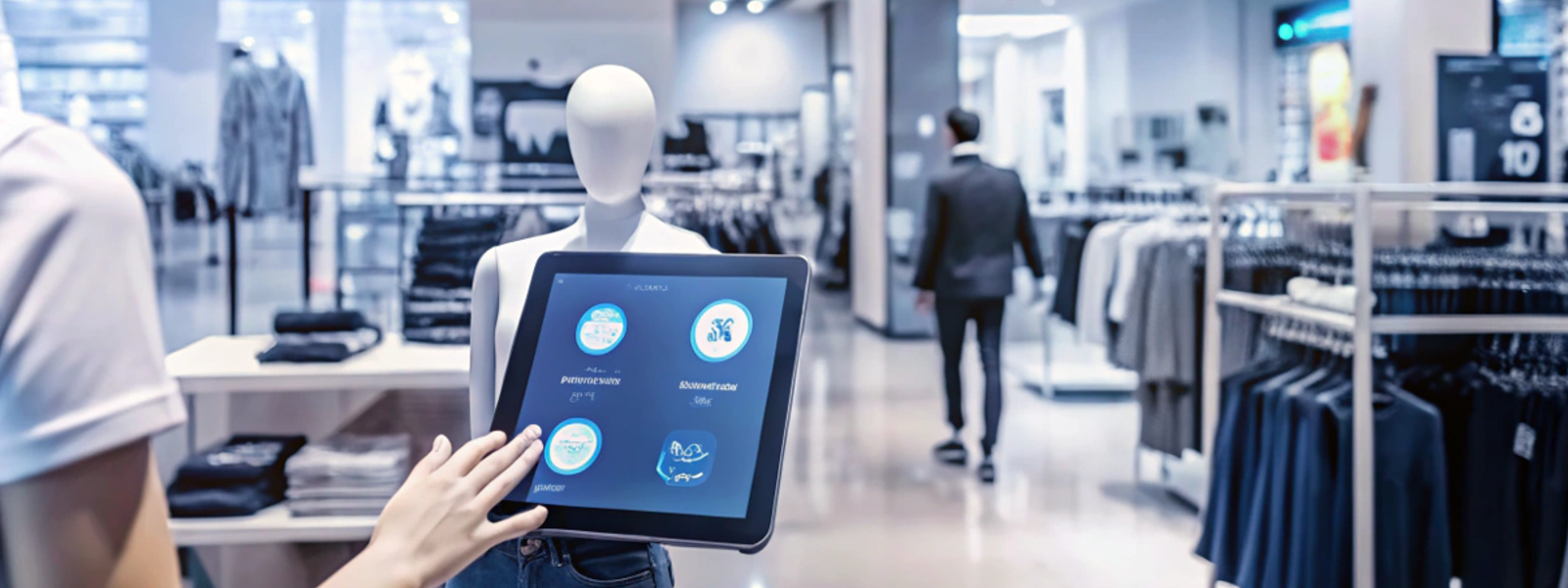Embracing the IoT revolution in retail transforms customer experiences and operational efficiency. Highlighting IoT's role in personalized interactions, inventory optimization, and its impact on retail banking. While challenges exist, strategic integration prepares businesses to harness IoT's potential, shaping a dynamic, customer-centric retail landscape.
Within the dynamic realm of retail, technology integration has revolutionized operations. Today, retail outlets place significant emphasis on employing smart retail technologies like cloud computing, Superapps, RFID, beacons, and others. Their primary goal is to provide interconnected retail services, enriching the shopping journey for customers. For instance, store owners strategically deploy sensors across pivotal sections of their establishments. These sensors establish a connection to the cloud through a gateway, enabling immediate analysis of data pertaining to products, sales trends, and customer behavior within the store. This digital transformation of retail industry and seamless integration of technology not only streamlines operations but also enhances the overall shopping experience, marking a significant shift in the retail landscape's evolution.
Power of IoT in Retail Industry
Envision a retail landscape where each interaction, transaction, and customer touchpoint seamlessly intertwine—a realm where shelves autonomously replenish, displays offer tailored suggestions, and checkouts flow effortlessly. This encapsulates the potential that the Internet of Things (IoT) holds for the retail sector. It promises a reality where every aspect of the shopping experience harmonizes, leveraging interconnected devices to enhance convenience and personalization. In this envisioned future, IoT technologies pave the way for intuitive operations, ensuring shelves are consistently stocked, displays cater to individual preferences, and the checkout process becomes friction-free. The transformative power of IoT in retail lies in its ability to create a cohesive and responsive environment that redefines convenience and customer engagement at every step.
As per Forrester’s report, retailers need to adopt a comprehensive "6E" approach enhancing retail operations with IoT —engaging, emulating, expanding, empowering, executing, and enabling—to create purpose-built physical spaces focused on enhancing customer experience (CX), attaining operational efficiency, and achieving targeted business goals. Embracing IoT is an integral part of this evolution. It involves crafting retail environments designed to meaningfully elevate CX, optimize operations, and drive specific desired outcomes. This strategy aims to not only engage customers effectively but also to replicate successful models, broaden market reach, empower staff, efficiently carry out plans, and facilitate the implementation of innovative technologies like IoT to transform the retail landscape.
Retail Landscape in the Age of IoT
In modern retail, IoT assumes a critical role by facilitating real-time data collection, process automation, and tailored experiences for customers. This technology empowers retailers to streamline their supply chains, enhance inventory management, and gain deeper insights into customer preferences. Moreover, IoT devices contribute to a more immersive shopping journey. Retailers strategically position beacons across their stores, enabling communication with customers' smartphones. Through this interaction, personalized offers, recommendations, and discounts based on location and purchase history are delivered. This tailored approach not only boosts customer satisfaction but also significantly heightens the potential for successful sales conversions. It’s not just about connecting devices; it's about revolutionizing the entire shopping experience.
IoT: The Catalyst of Retail Digital Transformation
IoT presents an expansive and transformative realm of possibilities within retail, surpassing mere enhancement of customer experiences to revolutionize the fundamental workings of retail operations. Picture this: a grocery store equipped with real-time monitoring of temperature-sensitive zones, ensuring constant freshness and top-notch quality. Likewise, envision a clothing store where customers can virtually try on outfits, eliminating the need for physical fitting rooms. These aren't abstract visions of the future; they're tangible realities achievable through the adoption of IoT technology.
Fundamentally, IoT reshapes the retail landscape by facilitating real-time monitoring, fostering seamless customer interactions, and introducing innovative experiences that redefine how consumers engage with products and stores. It empowers retailers to maintain quality standards consistently, offering customers a new level of convenience and interaction. By harnessing IoT's capabilities, retailers can create immersive, tech-driven experiences that blur the lines between physical and digital shopping, setting a new standard for retail engagement.
Enhancing Retail Operations with IoT Solutions
IoT stands as a pivotal strategic instrument reshaping the core operations of retail enterprises. Its integration empowers retailers to explore predictive inventory management, prevent theft, streamline supply chains, and tailor marketing initiatives. This amalgamation of IoT and machine learning unlocks unprecedented avenues for understanding customer preferences, providing invaluable foresight to businesses in predicting demand patterns and fine-tuning stock levels accordingly.
Through IoT, retailers gain real-time visibility into their inventory, allowing them to forecast needs accurately. Theft prevention becomes proactive, with smart sensors and surveillance systems identifying anomalies and triggering immediate responses. Supply chains become more agile and efficient, responding dynamically to changing demands and market trends. Additionally, IoT-driven personalized marketing campaigns deliver targeted messages and promotions to customers, fostering deeper engagement and loyalty.
The symbiotic relationship between IoT and machine learning stands as a testament to the transformative impact these technologies offer in retail. They don't just optimize processes; they revolutionize how retailers understand, interact with, and cater to their customer base, paving the way for a more agile and customer-centric retail landscape.
Digital Transformation Redefining Retail Banking
IoT's impact isn't confined to conventional retail; it extends its reach into the banking sector as retail banking digital transformation, revolutionizing the customer experience. Picture a banking landscape where services are customized to match individual preferences, smart ATMs forecast cash demand, and branches are curated for a personalized, technology-driven encounter. This digital metamorphosis is fundamentally reshaping how retail banking connects with customers, catering to their ever-evolving requirements.
In this transformed banking environment, IoT enables a tailored and responsive approach, offering customers services and solutions aligned precisely with their preferences and behaviors. Smart ATMs equipped with IoT capabilities use data analytics to anticipate cash requirements, ensuring seamless and uninterrupted access to funds. Branches are no longer mere transaction hubs; they evolve into immersive spaces where technology intertwines with personalized service, enhancing customer engagement and satisfaction.
The integration of IoT in banking marks a paradigm shift, propelling institutions toward a future where customer-centricity is amplified through technology. It's a journey that redefines the banking experience, blending convenience, personalization, and innovation to meet the dynamic demands of modern-day customers.
IoT Use Cases
- Self-Checkout - Revamping the checkout process through IoT integration alleviates retail's labor-intensive aspect. Crowded stores prompt customers to abandon purchases due to lengthy queues, but IoT-driven checkout automation offers a remedy. For instance, IoT-enabled systems can effortlessly scan item tags, charging customers' mobile payment apps upon exit. Benefits include enhanced customer satisfaction, minimized staff costs, improved employee productivity, and optimized space utilization, shaping a seamless retail experience.
- Customized Marketing - Customizing marketing endeavors become achievable through IoT implementation in retail. Connected sensors and devices gather extensive customer data, enabling personalized marketing campaigns. Retailers utilize IoT to tailor ads, introduce customized programs, provide targeted discounts, and curate content for distinct customer segments, aligning with their business objectives. This amalgamation of technology and retail strategy showcases the transformative power of IoT, enabling enhanced customer engagement and more effective marketing approaches.
- Inventory Management - Persistent inventory inaccuracies plague retailers, leading to overstocking, stockouts, and shrinkage. The integration of IoT within retail emerges as a definitive solution to automate inventory tracking, resolving these persistent issues. Introducing intelligent inventory management systems utilizing RFID tags, store sensors, beacons, digital price tags, and video monitoring bolster procurement planning throughout the supply chain. Leveraging IoT data analytics, these systems enable automatic reordering when inventory shortages occur, ensuring seamless restocking processes and addressing inventory management challenges comprehensively.
- Smart Stores - Innovative smart store technology encompasses roaming robots, automated inventory monitoring, and instant point-of-sale systems, aimed at delivering hassle-free shopping experiences. This automation not only slashes staffing costs but also incentivizes customers to revisit and make additional purchases. These advancements in retail, driven by IoT integration, prioritize convenience, offering seamless checkout options and enhancing overall shopping satisfaction, thereby fostering customer loyalty and increased sales.
- Smart Warehouses - Efficient product storage significantly impacts shipping and customer rollout, prompting the emergence of smart warehouses to automate these processes. Leveraging IoT, these facilities streamline operations, enabling easier item retrieval, minimizing damage, and boosting overall efficiency and productivity. The utilization of IoT technology in retail warehouses enhances inventory management, transforming traditional practices. Through improved organization and automation, these smart warehouses optimize processes, ensuring smoother operations, reduced errors, and heightened productivity, ultimately benefitting the retail industry.
Challenges and Triumphs in the IoT Retailing Industry
The potential of IoT in retail is indeed revolutionary, yet it comes with its set of challenges. Privacy issues, data security, and the intricate nature of integration require meticulous planning and substantial investment. However, the benefits surpass these obstacles by far. The seamless incorporation of IoT solutions yields amplified customer satisfaction, elevated operational efficiency, and most importantly, a substantial competitive edge within the market.
Addressing privacy concerns and ensuring robust data security becomes imperative in leveraging IoT effectively. Retailers must navigate the complexities of integrating diverse IoT devices and systems, demanding strategic planning and resource allocation. Despite these hurdles, the rewards are abundant. IoT's ability to harmonize various aspects of retail operations leads to streamlined processes, enriched customer experiences, and a strengthened market position.
Embracing IoT entails a transformative journey, one that demands diligence in overcoming challenges but promises immense dividends. When executed thoughtfully, the integration of IoT technology reshapes the retail landscape, elevating businesses to new heights of efficiency, innovation, and customer-centricity, thereby cementing their position as leaders in an increasingly competitive market.
IoT Innovations Reshaping Retail Experiences
The expanding landscape of IoT in retail encompasses various innovative technologies. Among these advancements is augmented reality (AR), a tool that superimposes digital data onto the physical world. AR holds the potential to revolutionize customer-product interactions by enabling visualizations of items within personal spaces or offering virtual try-on experiences for clothing.
Another notable technology gaining momentum within retail is blockchain. This technology presents a solution to supply chain transparency concerns by establishing secure records of all transactions. By meticulously recording each transaction, blockchain ensures the genuineness of products while acting as a barrier against counterfeit goods infiltrating the market. Its decentralized and immutable nature provides a robust foundation for maintaining the authenticity and traceability of products throughout the supply chain.
These emerging IoT technologies are reshaping retail experiences, offering new ways for customers to engage with products and enhancing the integrity of supply chains. AR opens avenues for immersive shopping encounters, while blockchain fortifies transparency and trust, reinforcing the integrity of retail operations.
Conclusion
IoT stands at the forefront of reshaping the retail shopping encounter. Its impact spans from tailor-made shopping journeys to optimized inventory control and amplified customer interaction. In essence, IoT redefines the conventional retail scene, fostering innovation across the board. As technology progresses, IoT's influence will continue to mold the retail landscape, forging a globally interconnected and frictionless shopping environment for consumers. This evolution heralds a future where every aspect of shopping becomes more attuned to individual preferences, where stock levels are finely tuned, and where customer engagement reaches new heights of personalization. IoT's ongoing integration promises to revolutionize how people shop, setting the stage for an era of seamlessly connected retail experiences across the globe.



